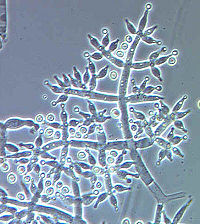
Photo from wikipedia
The incidence of invasive sino-pulmonary diseases due to non-Aspergillus hyaline molds is increasing due to an enlarging and evolving population of immunosuppressed hosts as well as improvements in the capabilities… Click to show full abstract
The incidence of invasive sino-pulmonary diseases due to non-Aspergillus hyaline molds is increasing due to an enlarging and evolving population of immunosuppressed hosts as well as improvements in the capabilities of molecular-based diagnostics. Herein, we review the following opportunistic pathogens known to cause sinopulmonary disease, the most common manifestation of hyalohyphomycosis: Fusarium spp., Scedosporium spp., Lomentospora prolificans, Scopulariopsis spp., Trichoderma spp., Acremonium spp., Paecilomyces variotii, Purpureocillium lilacinum, Rasamsonia argillacea species complex, Arthrographis kalrae, and Penicillium species. To facilitate an understanding of the epidemiology and clinical features of sino-pulmonary hyalohyphomycoses in the context of host immune impairment, we utilized a host-based approach encompassing the following underlying conditions: neutropenia, hematologic malignancy, hematopoietic and solid organ transplantation, chronic granulomatous disease, acquired immunodeficiency syndrome, cystic fibrosis, and healthy individuals who sustain burns, trauma, or iatrogenic exposures. We further summarize the pre-clinical and clinical data informing antifungal management for each pathogen and consider the role of adjunctive surgery and/or immunomodulatory treatments to optimize patient outcome.
Journal Title: Journal of Fungi
Year Published: 2023
Link to full text (if available)
Share on Social Media: Sign Up to like & get
recommendations!